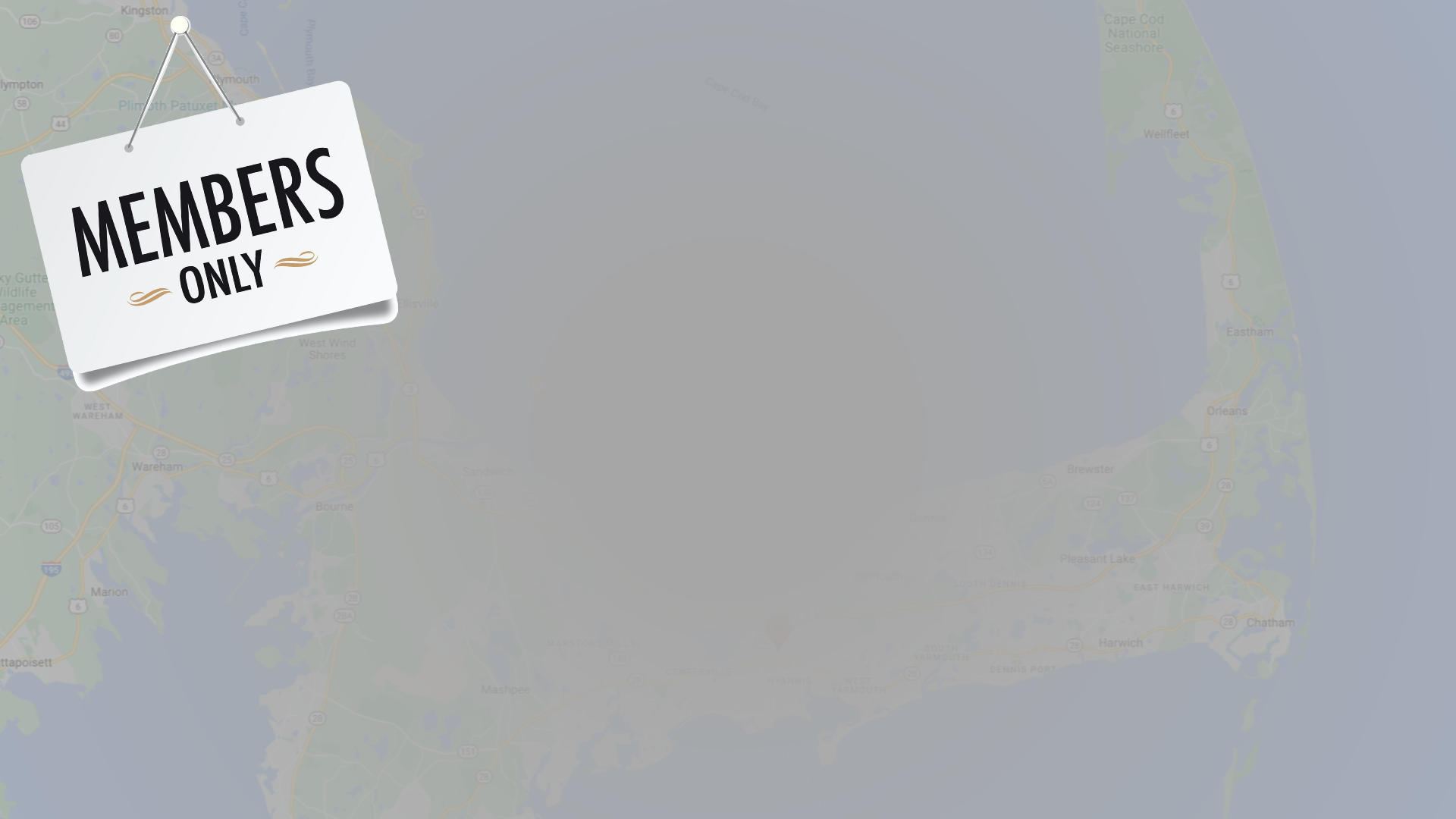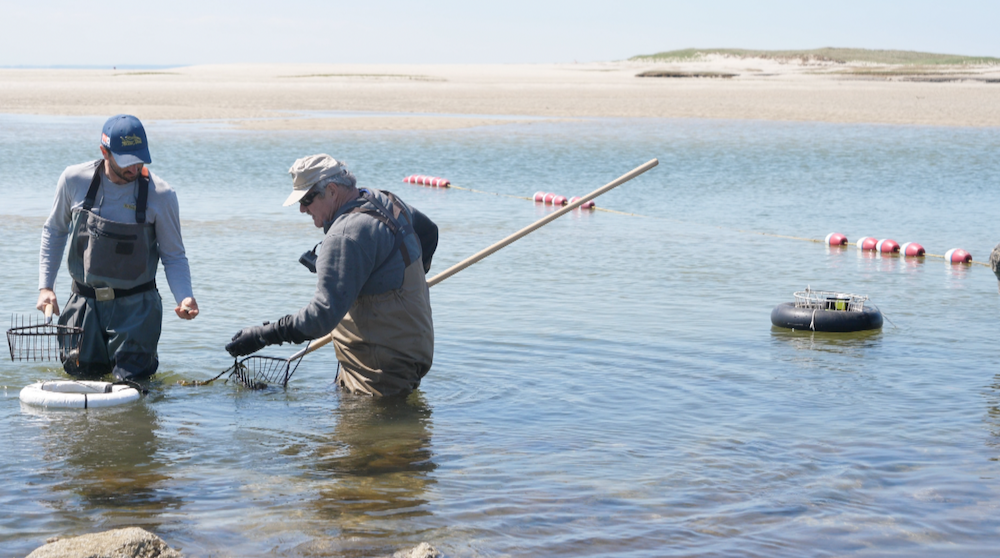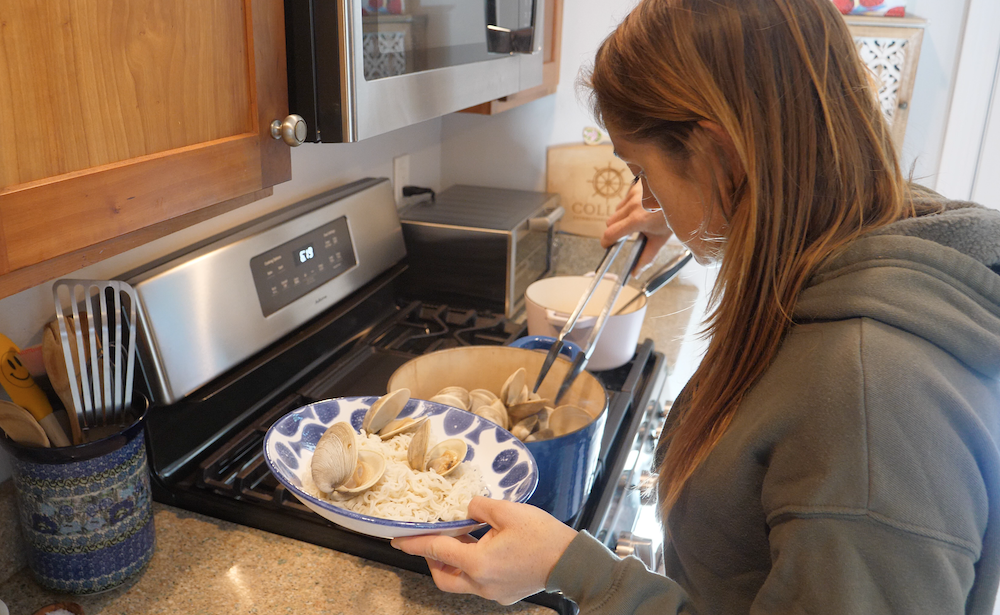Quahog is a universal term for any hard shell clam. Perhaps you are familiar with littleneck clams and cherry stone clams, which also fall under the general term of quahog.
I imagine the word quahog probably comes from the indigenous Wampanoag language. The Wampanoag people lived happily on Cape Cod for thousands of years before Europeans arrived, and quahogs were an important part of their diet.
In this post I'd like to "bring you with me" on one of my 2022 quahogging adventures.
You can use the table of contents below to skip to certain sections of this article, or simply continue scrolling for Cape Cod quahogging tips and advice, as well as information about how you can start quahogging on your own.
Quahogging with MFCC member Richard Banks
The afternoon of May 25th 2022 was warm and sunny, with a light breeze blowing over the marsh grass towards a tranquil Cape Cod Bay. It was a beautiful day for quahogging.
For this trip I would be clamming with longtime My Fishing Cape Cod member Richard Banks.

Over the years, Richard has been a very helpful My Fishing Cape Cod member - especially when it comes to shellfishing.
Richard wrote this very popular oystering article, and he's also contributed many posts to our shellfishing forum.

Our plan, as Richard explained, was to harvest the quahogs during low tide use clamming rakes. I was eager to get started, as I often am at the beginning of any sort of fishing or Cape Cod adventure.
Quahogging on Cape Cod
There are many spots throughout Cape Cod where you can harvest quahogs.
Each town on Cape has areas where it's legal to dig for clams, and other areas where it's not legal to dig for clams.
For this trip, we would be quahogging at the beach shown in the image below.

Terns and piping plovers were swirling overhead as we walked down the shoreline to one of Richard's favorite places to go quahogging.
"See that little bunch of rocks there? That's the spot", said Richard. We entered the water by the rocks, just off a marshy bank, and got ready to start raking.

Clamming Rakes & How to Use Them
We started digging using a nine tooth clamming basket rake.
Richard showed me the teeth (also called tines) of the clamming rake and emphasized how careful one must be when using a clamming rake.

The tines of the rake are quite sharp, to say the least.

"The tines of the clamming rake will cut your boots, they'll cut your fingers, they can do some deadly damage, so be careful of those", Richard explained.
Technically speaking, the clamming rake is a basket rake. What you do is reach the clamming rake out into the water, and then turn the tines down so they go into the sand.
Work the rake into the sand a bit and you'll start to hear the tines raking against the rocks and other debris.

Continue raking it through the sand, bringing the clamming rake closer to you. As the clamming rake gets closer, lift the pole up out of the water.
Once you have a basket full, give the clamming basket a twist, turn it up, and reach in to cull out any clams that are in there.

Finding even one quahog is a good sign, and in some areas you'll be able to quickly harvest a whole bunch of quahogs. When you start bringing up 10 or 12 quahogs in the clamming basket at one time, then that's a good haul.
On this day it didn't take long for Richard to start raking up some keeper-size quahogs.

"Come right down in here Ryan, on the other side of me" Richard said. "Face me and then start pulling the rake back towards you."
It was finally my turn to go to work and dig up some quahogs of my own. I've quahogged before, but I'm far from an experienced clammer, so I continued peppering Richard with questions.

"Any idea how deep they can dig down into the sand?", I asked.
"It's usually about the length of the tines".
I dug the rake into the sand and could feel it scratching against some rocks and perhaps a quahog or two. Once I finished I lifted the clam rake from the water and found a few nice quahogs in the basket.
"Excellent! I got a couple now too!" I remarked.
I put the quahogs into the basket and continued raking. After all, I was hoping to harvest enough quahogs so my wife Lauren could make her Drunken Quahog recipe, which is delectable!
Clamming Gauges
One essential piece of clamming equipment is a clamming gauge. Quahogs are legal if they can't pass through the opening of the clamming gauge on their hinge side.
Remember that this only applies to quahogs, which are hard shell clams.

With soft shell clams, to be a keeper the clam can't pass through the clamming gauge lengthwise.
Oysters have to be longer than the length of the clamming gauge, which is three inches long.

"Now what's interesting is that this clamming gauge and the rib rake's tine openings are the same dimension. The beauty of that is when you're raking up small quahogs, they'll just fall out of the basket", explained Richard.
Of course you still need to check your catch and cull it out, but for the most part, if the quahogs are in your clam rake's basket, then you can pretty much count on your quahogs being of legal size.

Additional Clamming Equipment
The standard recreational clamming basket is 10 quarts, which is often the limit for quahogs depending on the season and the town.

Richard uses a styrofoam ring on his basket. Inflatable rings, pool noodles, or a boogie board cut with a large hole in the middle can also work great. You can often pick these up for free at beach dumpsters after a busy summer day.
Gloves are good to protect your hands when pulling out the rocks from the rake basket, or when digging through the muck to find the quahogs.
Cape Cod's Quahog Seeding Programs
The area proved to be productive and there was certainly no shortage of quahogs. The main reason being, is that this area (along with many others throughout Cape Cod) are seeded.
Each year, towns on Cape Cod purchase different size quahog seed and grow them to supplement the natural populations within each town. Once they are large enough, they are available for harvest by those with shellfish licenses.

Yes 100% wild quahogs exist in many spots, but the most heavily fished areas are seeded by Natural Resources departments through the Cape region.
"Can you imagine how productive the quahogging was here 500 years ago? I can only imagine how abundant the seafood was back then" I said to Richard.

We continued chatting about how productive the fishing, lobstering and shellfishing must have been in this exact spot hundreds, as well as thousands of years ago.
Richard also mentioned how these quahog shells are the shells that the indigenous people of Cape Cod used for Wampum. I'm not quite sure how it worked or what it was based on, but the quahog shells were part of their monetary system.
A Special Quahogging Program for Veterans
One thing every town on the Cape has is a special shellfishing program for veterans.
If you're a veteran like Richard, then you can go to whatever town you're in (even if you're not a resident) and get a town shellfishing permit at the resident rate.

For example, Richard lives in Yarmouth, but because he's a veteran he could go to Brewster and also get a Brewster permit at the resident rate. This can add up to some real big savings if you want to shellfish all over the Cape.
If you're a veteran, then Richard encourages you to inquire, get yourself a permit by visiting a town's Natural Resources department (here's a link to Yarmouth's department). You can then start harvesting quahogs from different towns throughout Cape Cod.
Quahogging Rules & Regulations
If you do start quahogging in different Cape towns, then just be aware that each town on Cape Cod has different quahogging rules and regulations.

For example, one town might say you can't go shellfishing if the air temperature is under 32 degrees. The town next door might say you can't go shellfishing if the air temperature is under 29 degrees.
Because each town has its' own rules, you need to make sure you know what they are. You can get an overview of general rules and regulations by clicking a toggle below.
However be sure to visit a specific town's Natural Resources office or webpage for town-specific rules and other information.
Town-specific regulations
Shell fishing permits
Resident vs. non-resident permits
When you can go
Minimum size
Cleaning your Quahogs
Digging the quahogs is the fun part, but before you cook them up, you'll probably want to give the quahogs a bit of a cleaning.
To clean the outside of the quahog, Richard uses the rough side of a sponge to remove any film that might be on the quahog shell. He then gives the quahog a good rinse.

At this point your quahogs should look nice and clean.
Cleaning the quahog shells doesn't take much skill or effort, but when you have 10 quarts of quahogs, be prepared to spend a little time cleaning up your clams before you cook them.
Storing & Cooking Quahogs
You can store the quahogs in your frig for several days. Some people freeze them for eating later. Richard prefers to keep them alive until it's time to cook.
Speaking of cooking, you can eat quahogs any number of ways. A lot of people prefer to eat them raw, with the smaller quahogs being the best for this treat.
You can also steam quahogs on the stove top. The quahogs will be done once the shells open.

You can also put quahogs directly on the grill and wait a few minutes for them to pop open. The brine inside will be very hot so give the quahogs a little time to cool down before eating.
Richard also likes to remove the bellies of the large quahogs, and then dice up the meat for use in chowder, with pasta or for making stuffed quahogs.
While on the topics of cooking quahogs, I wanted to make sure I shared with you some of the quahog recipes that we have here on the site.
I speak from experience when I say that these recipes are winners!
In Conclusion
I had a wonderful experience quahogging with My Fishing Cape Cod member Richard Banks, and I learned a lot. Thanks again Richard for inviting me along on this trip!
Richard and I also captured the experience on film and I will be airing footage about quahogging this March as part of season 6 of My Fishing Cape Cod TV on NBC Sports Boston. I hope you'll tune in!
Thank you as always for reading this post. I hope you enjoyed it! Wintertime has arrived on Cape, but I assure you it won't be long until it's time to go quahogging again.
Tight lines!




Oyster season and soft shell season are closing in some areas. While some areas allow
quahogging year round others have date restrictions on when and where you can go. Be sure to check your local rules and regs especially what areas are opened or closed before heading out. If you have any questions be sure to reach out.
Was out this morning in Yarmouth and filled the basket
Even in winter you can find some great shell fish.
That is great to hear Richard! Nothing beats the cold salty air this time of the year, which really makes me feel alive. Fresh seafood is a nice bonus too.
Very informative post, Ryan! I started quahogging in Falmouth about 6 years ago. Here are a few things I learned that made quahogging more fun and more productive for me…
1) First, you don’t need to dig super aggressively and tire yourself out. I learned this early on, when I was digging hard, exhausting myself and not finding much. Near me were two elderly men, scratching nice and easy and turning up lots of clams. By watching them, I learned how to scratch until I feel a clam under the tines, then dig the tines under it and pull it out.
2) And once you find your first clam, don’t move. There will be more nearby. Work the rake in a semicircle around the same area and you should find more.
3) Scratching the tines over a clam feels a little different than scratching a rock. Pay attention to the feel and with time, you’ll be able to tell the difference.
4) Finally, to avoid waste and help preserve the resource, think about how many clams you will really use, and only take what you need.
Excellent tips Ken. Thank you very much for sharing. I really appreciate it!
Ryan and Richard,
Nicely done post and tips! I will add a couple tips for less strain on the body.
First is to use those very long handle rakes I see in your photos instead of shorter ones. That way, I can rest the top of the handle on my shoulder and rake by walking backwards. Less strain on the arms that way.
Second is carrying your heavy basket of clams back to your vehicle if you are alone and have a long walk. I use an inflatable basket ring that I remove and put around my neck. Then I can lift the rake and basket over my head and rest it on my shoulder with less pressure on my shoulder bones. I’ve seen others use old golf carts and sleds. If you have a partner, then simply feed the rake through the basket handle and each hold one end.
Thanks for sharing those tips Ron. Much appreciated!
Great post Ryan! This could double as a great story and comprehensive guide to getting started shellfishing for quahogs. My wife and I go for quahogs just West of there on the North side of Barnstable. It’s become a fun hobby for us over the past few years. She doesn’t fin fish much but she pushed me to get back into shellfishing after a number of years. The other great point you highlighted is there are SO many great dishes you can make with fresh quahogs. Whether it’s my personal favorite, stuffed quahogs or a clam linguini or chowder there are plenty of options!
Last thing is your point about local rules – it’s important to know. In Barnstable they have a rule that you can’t dry dig (rake above the water line) at a certain air temperature but you can rake in the water. This was news to me when the Natural Resources officer explained it to me… I’m not sure about other towns but I know in Barnstable they frequently change the open/closed status of various shellfishing areas. They are good about posting signs at common “Ways to Water” access points too. Barnstable also offers a well-organized and frequently updated website, complete with current PDF maps of specific portions of town to show closures as well as a searchable GIS tool that shows all closures. It makes it very easy to do a last minute “sanity check” to ensure the area is open before you start raking.
Full rakes! -Matt
Awesome comment Matt, thank you very much for posting!
I met Richard through MFCC, and he taught my family how to go clamming a few years ago. My wife and I now take our son and daughter clamming every summer when we’re on the Vineyard – it is great family time, and everyone loves quahogs on the grill. Thank you, Richard!
That’s terrific! You are making some special memories for your family. I’m really happy to hear that. Happy New Year Graham!
Nicely done!!!! It was a pleasure to get together with you and I look forward to additional trips in the future. Happy New Year!!!!
Sounds good Richard! Thanks again for a fun time. The video is coming along nicely as well and I’m looking forward to sharing it in the upcoming tv show season.
Ryan,
Enjoyed the post very much. I am familiar with the area that you visited, although
my wife and I usually concentrate on hunting for soft-shell clams there. I believe
that your information was accurate and informative, and would be of help to anyone
contemplating clamming. Also, the recipes look terrific! Looking forward to seeing
the upcoming episode on MFCC TV this March. Keep up the great work!
Thanks for the comment Ron. I might head back to that area next year to try for soft shell clams. Maybe I’ll see you over there! The recipes were pretty delicious. Let us know if you give any of the recipes a try. Happy New Year!